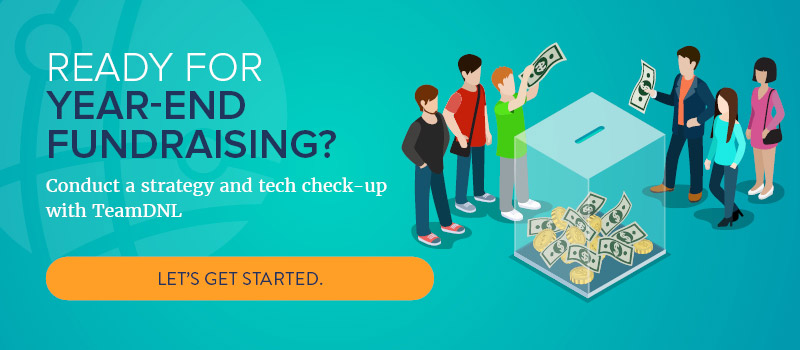
The end of the year means one thing for nonprofit organizations —fundraising, and lots of it.
Year-end giving plays a crucial role in the yearly strategies of practically every nonprofit. Whether your year-end campaigns help fund specific projects, support your annual fund, or simply make up critical fundraising gaps after a year of disruptions, your team probably already puts considerable thought into preparing for the end of the year. However, taking some extra time to update and refine your year-end giving strategies is never a bad idea.
At DNL OmniMedia, we work with nonprofits to develop customized solutions that unite their fundraising, technology, and marketing strategies in new ways. We’ve found again and again that taking a comprehensive, top-down approach is the single best way to unlock new levels of success for your organization! Here’s what we’ll cover in our guide to year-end fundraising:
- Year-End Giving Statistics
- Planning a Winning Year-End Giving Campaign
- Best Practices to Finish Year-End Giving Strong
- Ideas to Keep Your Year-End Giving Campaign Fresh
- Wrapping Up
Ready for your crash course in year-end fundraising in the virtual era? Let’s dive in.
Year-End Giving Statistics
There’s no downplaying the importance of a strong year-end giving strategy. In fact, past years have seen up to 10% of all annual fundraising occur in the last three days of December alone.
Nonprofits should develop dedicated strategies for this time of the year. To tap into these opportunities, roughly 54% of nonprofits begin planning their year-end fundraising campaigns in October, and about 8% start as early as June. It’s best to take a tip from past year-end fundraising data, which reflected the following:
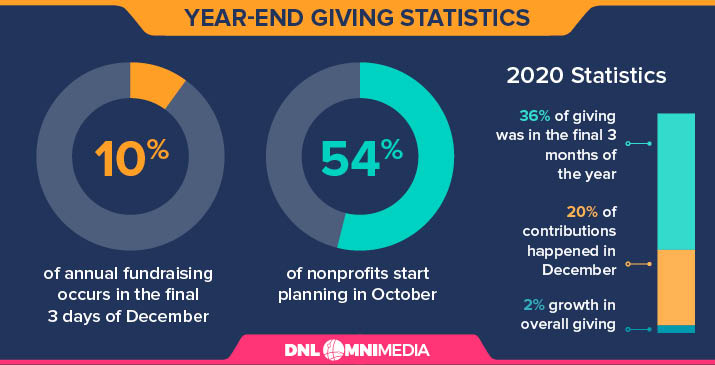
- There was a 2% growth in overall giving year-over-year.
- 20% of the year’s contributions were made in December alone.
- October, November, and December represented 36% of charitable giving.
These statistics tell us two things:
- Even during times of financial and personal crisis, supporters continue to give to nonprofits—and more than ever before.
- Just as in past years, the year-end season is a powerhouse for raising the bulk of a nonprofit’s funds.
There are a few different reasons behind why year-end giving holds strong year after year, and understanding them can help you plan an effective campaign.
First, the holiday season tends to put supporters in a generous mood, reminding many to be thankful and give back when they’re able. This means that people are often more receptive to appeals, especially those that use effective storytelling. Additionally, December is the last chance for individuals to make tax-deductible donations. This is often a huge driver of gifts in the final days of the year.
Planning a Winning Year-End Giving Campaign
We’ve covered the outlook for year-end giving—but these results depend on your organization developing a strategy to finish the year strong.
Your year-end fundraising campaign is the perfect opportunity to make the most of all the lessons you’ve learned throughout the year! Your holiday season campaigns should only get better and more effective each year.
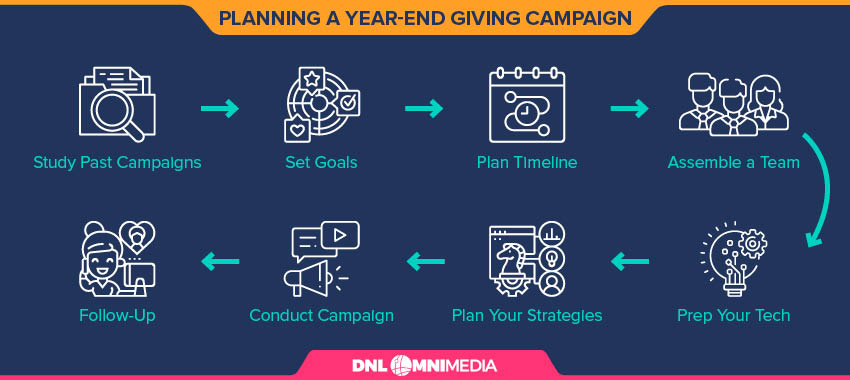
Still, you have to put in some upfront investment of time and strategic planning to see meaningful (and sustainable) results. Let’s get started.

Study your past year-end giving campaigns.
Before you begin outlining your campaign for this year, take a retrospective look at the fundraising and marketing performance of your past campaigns. Review your data and allow that information to inform your strategy for this year.
There are a number of major insights that you can draw from the data from previous year-end campaigns. To get started with past campaign data analysis, sit down with your team to compile a list of questions that would be helpful to have answered as you plan your upcoming campaign. Then, use these questions to guide your data analysis.
You may inquire about:
- Which weeks or days have been the most successful for soliciting donations during past year-end giving campaigns?
- Which digital outlets (social media, email, your website, etc.) see the highest donor engagement and conversions?
- What was the average donation amount across the entire campaign?
- Which segments of your donor base made the most individual donations?
- Which segment made the biggest donations?
- How many of last year’s year-end donors were retained from the year before that?
- What was your cost per dollar raised for your last year-end giving campaign?
Work with your team to derive insights and then connect them to your current context. How can last year’s lessons impact this year’s strategy? You need to make sure that every technique you employ will be effective at actually engaging your donors, building deeper relationships with them, and inspiring them to give.

Set concrete goals and guidelines for your year-end campaign.
Using your insights from the previous step, work with your team to start laying out some concrete goals and guidelines for your year-end fundraising campaign. Follow these general steps to start narrowing it down:
- Determine what type of campaign you’ll conduct. Consider the overarching purpose of your campaign, which will likely fall into one of two categories: project-based and annual or otherwise unrestricted. With project-based campaigns, the funds you raise will likely be restricted—meaning you can only use those funds for the predetermined project (like a capital campaign or specific program). On the other hand, the latter type allows you to use funds wherever necessary, whether general operating costs or projects. Your whole team needs a clear, shared understanding of your year-end giving campaign’s core purpose because it will inform your messaging to donors.
- Set some specific fundraising goals. Use your historical data to determine how much you want to raise this year-end giving season. Set an ambitious (but attainable) goal above your previous record, and be ready to invest time and effort into strategy development. From there, consider creating a gift range chart to strategically map out your goal. This breaks your total fundraising goal down into separate gift ranges, along with listing how many prospective donors you’ll need to convert in each range in order to reach your goal. The main idea is that you need a specific fundraising goal to anchor all of your strategies and your team’s efforts.
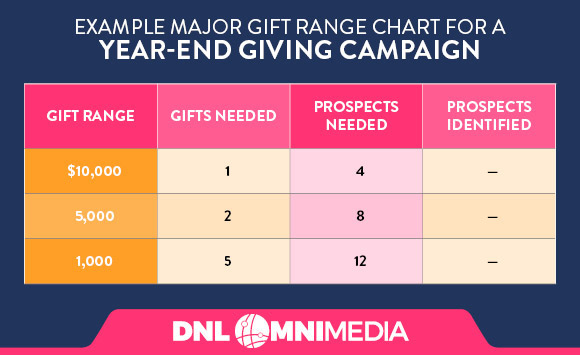
- Determine KPIs for your year-end giving campaign. KPIs (or key performance indicators) are the third specific guideline that you should set. Review the metrics that you focused on when analyzing last year’s campaign. What stuck out to your team as areas that needed considerable improvement? Are your goals more revenue-based or engagement-based? Common KPIs include total individual donations, total fundraising revenue, cost per dollar raised, donor retention over the last campaign, online donor engagement, and new donor acquisition.
For each of these parameters, make sure you have a system built into your strategy for measuring your progress and staying on track. This could include benchmark check-in dates or even automated reports.

Plan out your year-end campaign’s timeline.
When it comes to year-end fundraising, your team should get started as early as possible.
Of course, exactly when you begin planning your campaign will depend on what else you have going on, but there’s a general timeframe that tends to work well for nonprofits and produce valuable results. Here’s how it typically breaks down, month-by-month:
- ASAP (Now!): Your team should focus on developing and outlining a concrete fundraising and marketing strategy, just as you do for other major campaigns. Now is also the time to consider if you’ll need support from an outside fundraising or technology consultant. For example, if your tech infrastructure needs strategic updates before you can launch your year-end campaign, you’ll need plenty of time to get everything running smoothly and to ensure your whole team is on the same page with using your new tools.
- September: If you’ve identified new tools to invest in or tech updates to make, now’s the time to get them up and running. This includes both donor-facing outlets, like advocacy apps, and internal tools, like CRM upgrades. From there, focus your efforts on spreading the word with a targeted email campaign to specific segments of your audience. Make sure to clearly communicate everything they’ll need to know to get involved in your year-end campaign.
- October: Your year-end giving campaign should be picking up steam as you begin to execute the fundraising and marketing campaigns that you finalized last month. Early in the month, work with your corporate sponsors (or find smaller local partners if you don’t have sponsors) to arrange percentage fundraisers or promotional agreements. If you’re participating in #GivingTuesday, which is the Tuesday following Thanksgiving each year, make sure your marketing materials and website clearly express that. Begin marketing your #GivingTuesday campaign toward the end of the month.
- November: If you’re hosting any events, virtual or in-person, do everything in your power to make sure they go off without a hitch. The bulk of your efforts in November should focus on continuing to market your campaign to your entire donor base. Try to make your marketing strategies as engaging as possible, as the holiday spirit will typically make people more eager or inclined to get involved.
- December: Drive your year-end campaign across the finish line by emphasizing that December is the last chance for donors to make a tax-deductible gift. Consider offering DIY-style peer-to-peer fundraising, in which supporters can quickly launch their own pages to ask friends for donations in lieu of holiday gifts. Engaging social media campaigns that encourage supporters to share pictures or messages with a special hashtag are also a good way to encourage more small- to mid-size donations as the month draws to a close. If there are any prospective major donors that your development team has been courting, year-end events and personal meetings are effective for growing those relationships and hopefully making a successful ask.
- January: After New Year’s Day, thank everyone who made your year-end giving campaign a success. Post announcements, send thank-you emails, or reach out via phone or direct mail to those who were instrumental in helping you reach your goals. Double-check that everyone (especially mid-range and major donors) received all the necessary documentation for their donations. Review your campaign’s performance and make note of all the useful insights you learned during your year-end campaign.
The month-by-month breakdown above is a general outline of what works well for many nonprofit organizations. Of course, how your team decides to schedule your year-end giving campaign will depend on a number of different variables. Ultimately, you know what kind of timeframe will be best suited to your mission, organization, community, and audience. Take a flexible approach and adapt these best practices as you see fit.

Assemble your year-end fundraising team.
Having an organized, well-prepared team of staff and volunteers with clearly defined roles is crucial for the success of your year-end campaign.
Assemble your team well in advance of the campaign, most likely during the late summer or early fall. These departments should all be represented on your year-end team:
- Marketing and partnerships
- Stewardship/donor engagement
- Development or major gifts fundraising
As you assemble your campaign team, determine whether or not your nonprofit would benefit from the external guidance of a consultant. The most common reasons that organizations seek support for their year-end campaigns include:
- Tech guidance and services. This includes technology implementation (like migrating your organization to a new CRM) and custom development (like web design or custom integrations between platforms). If you’re already considering making an upgrade or need a customized solution for your year-end campaign, find a consultant early in the process to ensure there’s plenty of time to design, test, and implement your new solutions.
- Technology strategy development. A consultant can audit your toolkit and then find, implement, and customize new tools as needed. Next, they’ll lay out a plan for making the most of each tool at each stage of your fundraising campaigns, focusing on your particular goals.
- Fundraising strategy development. Suppose you want extra support around the specifics of your campaign’s structure, outreach strategies, gift range goals, or other elements of the fundraiser itself. In that case, a consultant can be an invaluable partner.
If you think your organization would benefit from working with a consultant for its year-end campaign, start considering your options now. Work with your board to decide on your goals and start researching candidates. There are tons of great nonprofit consulting firms out there, so start early!

Prep your tech for year-end fundraising.
For years now, technology has played a major role in year-end fundraising. Before you get too far into the year-end season, review your tech to make sure that your solutions are up to par. Common updates that you may need include:
- Investing in new fundraising technologies. For example, if you are planning to implement new hybrid fundraising events into your strategy for this year, you’ll want to invest in these new solutions early to ensure they’re well-integrated into your tech stack.
- Scaling up your existing solutions. This could mean investing in additional software licenses if your team has grown or even working with a consultant to build out key integrations between your main solutions.
- Investing in optimization-focused tools. This includes email automation tools, matching gift automation tools, and any other solutions that add efficiency to your team’s efforts.
- Cleaning up your CRM. Conduct data hygiene efforts to ensure your main database is free from errors, duplicates, and otherwise nonstandard data.
- Improving your digital presence. Your website, social media profiles, and email marketing efforts should all be up-to-date and aligned in one cohesive strategy. It’s especially important to bring your social profiles up-to-date.
If you’re unsure where to begin when it comes to optimizing your tech for year-end fundraising, partner with a nonprofit technology consultant now. This partner can conduct a full assessment and implement any suggestions needed to set your team up for success.

Plan your fundraising and outreach strategies.
Next, begin outlining the specific techniques, appeals, events, and marketing materials that will make up your year-end giving campaign.
There are a few popular year-end fundraising techniques and ideas that you’re likely already incorporating into your plans. These include:
- Events. Holiday parties are a great way to engage your target audience and incorporate fundraising elements, like silent auctions or raffles. More public-facing events, like fun runs or food drives, are also excellent for raising your campaign’s visibility throughout the entire community. If you’re continuing to host virtual or hybrid fundraisers, get started planning the logistics early to prevent last-minute technical difficulties.
- Giving days. A giving day is a timed fundraising challenge event. Challenge your audience to work together to contribute a specific total amount of donations to your cause within 24 hours. One of the most popular examples is #GivingTuesday. Nonprofits often arrange percentage or matching gift agreements with local retailers or corporate sponsors in order to boost the impact of these challenges.
- Pledge drives. This fundraising technique can be a very effective way to expand your audience and engage many donors quickly. The catch, though, is that you’ll need to take the effort to actually collect and process the pledged donations after the pledge drive period has ended.
You’ll also want to invest some time in developing a multichannel marketing strategy for your year-end fundraising. If you’re unfamiliar with the concept of multichannel marketing strategies, the main idea is using your various marketing outlets (like your website, social media, online and print ads, etc.) to all drive more traffic and readers to one another.
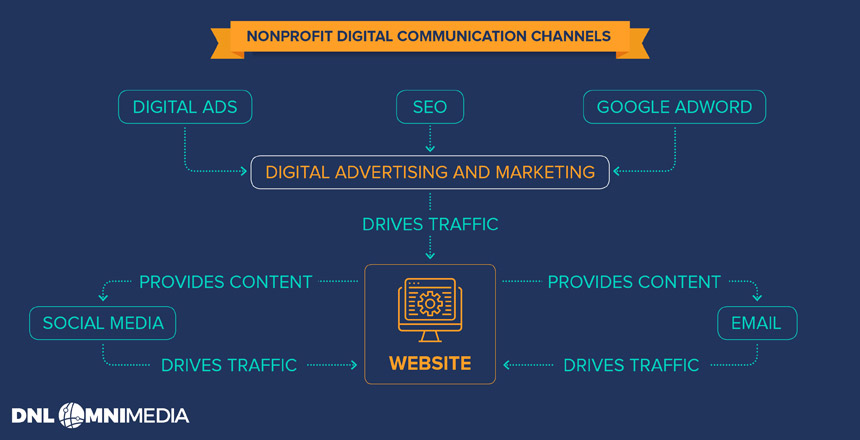
Lastly, you’ll want to target your messaging to particular segments of your donor base. This is a general best practice for any marketing effort, but it can be particularly effective for year-end fundraising. One common example of year-end fundraising is focusing on lapsed donors. These supporters have a proven interest in your mission, and the holiday season is the perfect time to reach out to them with targeted messaging.

Conduct your year-end campaign.
Once your team has worked through all the steps described above, it’s time to get started!
Follow along with the timeline that you established, sticking to your strategy as much as possible while also adapting as needed based on performance and donor engagement. If you selected specific KPIs and benchmark dates to use for measuring success, it should be easy to identify if your campaign is progressing well or if your techniques need tweaking.
This is also where the various solutions in your tech stack play an important role. Some solutions, such as Blackbaud’s Fundraiser Performance Management, allow for automated reminders to help your team stay on track. Explore the options in your CRM and fundraising solutions to see which resources are available to you.

Follow-up with gratitude and results.
After your campaign draws to a close and the new year begins, immediately thank all of your donors and participants. If you reached your goals, let your community know! Share final updates about the campaign and what you’ll be able to accomplish in the coming year thanks to all their help.
Additionally, now is a good time to make sure all of the data you collected over the course of the campaign has been properly reported and organized. Spend some time reviewing your performance. Some high and low points will probably immediately jump out to you, and it’ll be worth remembering those strategies for next year’s campaign.
Use the checklist below to begin planning your year-end campaign.
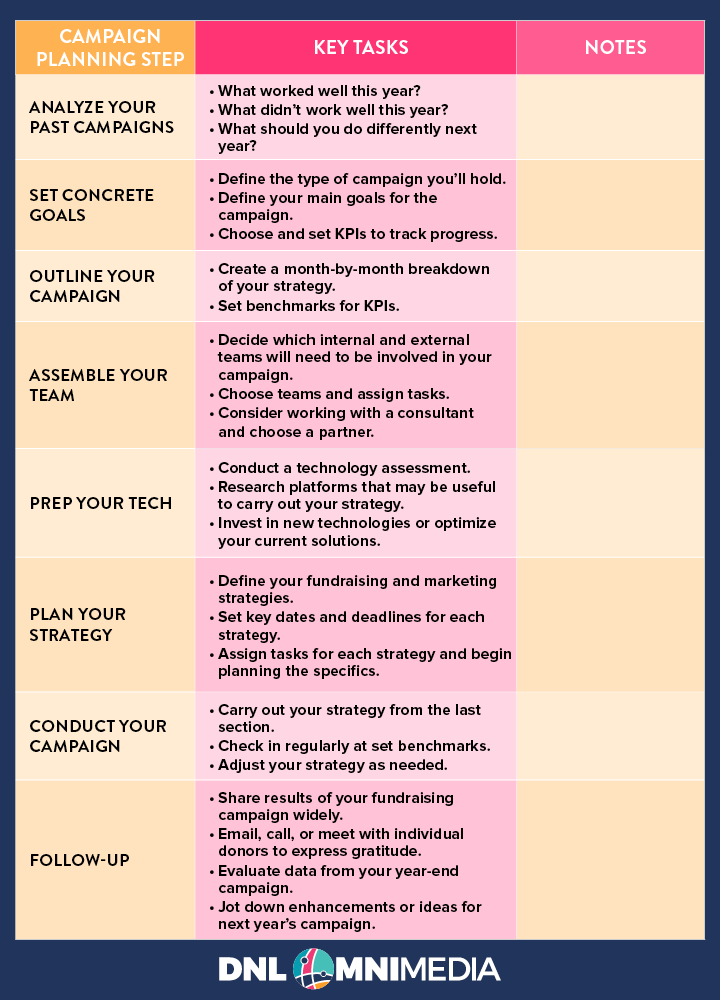
Download a version of the chart here.
Best Practices to Finish Year-End Giving Strong

Consider the role of virtual and hybrid fundraising in your campaign.
Virtual and hybrid fundraising is sticking around for the foreseeable future. The shift towards remote engagement has been successful for many organizations because virtual fundraising combines and taps into a few key trends:
- Online fundraising strategies developed and refined over the past decade
- Newly accessible and easy-to-use live streaming platforms
- The nonprofit sector’s growing understanding of the value of data
- Donors’ existing comfort with online engagement, live streaming, etc.
To make the most of the year-end season and set your campaign up for success, you’ll definitely need to incorporate one or more new virtual elements into your strategy. Here are a few ideas:
- Large-scale virtual events
- Social media campaigns
- Live appeals and activities
- Small-scale virtual events
Rather than focus on a single opportunity or outlet, like social media, use a mix of digital marketing tactics and virtual events (small- or large-scale). This will create a more dynamic experience for donors, help your campaign stand out, and create more touchpoints for donations to flow through.

Segment your donors and tailor your communications accordingly.
A huge part of securing a donation involves making the right ask, to the right person, at the right time. That holds true for the year-end fundraising season as well!
Consider segmenting your donor base into groups based on their past engagement with your nonprofit. Here are a few categories that you can use to segment your donors:
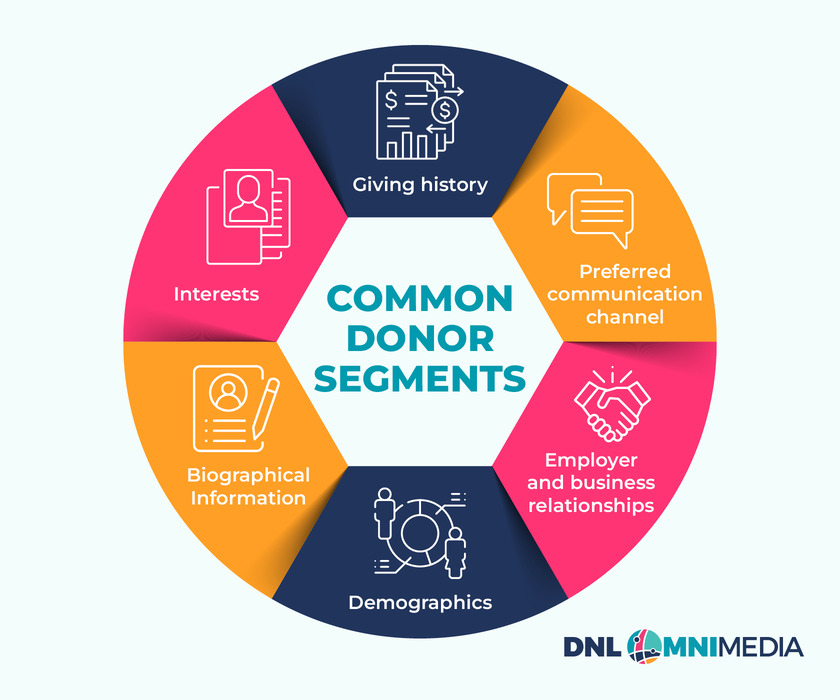
- Gift type
- Preferred communication channel
- Giving level
- Date of the last gift
- Employer
- Demographics (age, gender, location, etc.)
Then, you can use these segments to tailor your year-end appeals accordingly. For example, you can tailor your suggested giving amounts to be slightly higher than a donor’s past gifts to your organization, or you can send solicitations to a supporter based on their preferred communication channel.

Use storytelling to make your case.
Due to the holiday season, emotion-based year-end appeals are often incredibly successful. One of the best ways to incorporate emotion into your appeals is to tell a strong story.
Consider the impactful individuals involved in your nonprofit. Then, tell the story of why they’re working with your nonprofit, the actions they’re taking, and the impact they’re having! Any of the following would be great topics for year-end appeal storytelling:
- The motivations of a particular staff member, volunteer, or donor
- How a constituent’s life has been impacted as a result of your work
- How your nonprofit has grown over the years and the impact that has resulted
These stories will inspire other supporters to want to pitch in and have a similar impact. But remember, there is a wide spectrum of emotion that you can tie into your story, from happy to sad and everything in between. While not all stories will start off on the brightest foot—especially if they’re about constituents who were struggling in a tough situation—you’ll want to end the story on a more positive, motivating note.

Focus on donor-centric messaging.
Donor-centric messaging is that which centers the donor and their impact—rather than your nonprofit—as the driving force behind your mission. Consider the following examples:
- Example 1: “Last year, our nonprofit was able to provide 1,000 resource-filled backpacks to students in need. This year, let’s double that record!”
- Example 2: “Last year, your generous gifts bought 1,000 resource-filled backpacks for students in need. This year, let’s double that record!”
In the first example, the nonprofit and its impact are the focus. On the other hand, the second example emphasizes how crucial donors are in that impact. It’s much more successful at making a case for continued support!
Think of it this way: if a donor thinks that your nonprofit can achieve its goals without their help, they’re not going to give to you. There are many charitable causes that could use their donations as well! Donor-centric messaging assures the supporter that not only are their gifts welcome, but also needed when it comes to furthering the cause in which you’re both invested.

Create a cohesive experience across your various touchpoints.
This guide discusses many different touchpoints that you’ll use to interact with your year-end supporters. Social networks, email marketing, virtual event software, your website—the list can continue.
Aim to provide a cohesive experience across your various touchpoints, both so your donors trust the various technologies, and they grow familiar with your brand. To do this, you’ll want to carry your nonprofit branding elements across your tech and analog solutions, including elements such as your:
- Key messaging and mission statement
- Logo
- Typography
- Color palette
- Spelling and naming conventions
This is just a brief overview of the elements you can use to maintain consistency across platforms. Of course, the easiest way to maintain this consistency is to create nonprofit branding guidelines. This way, the various team members involved with carrying out your fundraising and marketing strategy have a template to follow.
Ideas to Keep Your Year-End Giving Campaign Fresh
Now, let’s walk through a few popular year-end fundraising ideas to get your creative juices flowing. The ideas we’ll cover are adaptable and reliable choices for organizations of all sizes, empowering nonprofits to engage supporters near and far.
We recommend developing a year-end campaign that incorporates a variety of these tactics, depending on your unique audience and past performance. By using a variety of techniques, you’ll reach more donors, create an engaging experience, and offer more opportunities for supporters to learn about your mission and make donations.
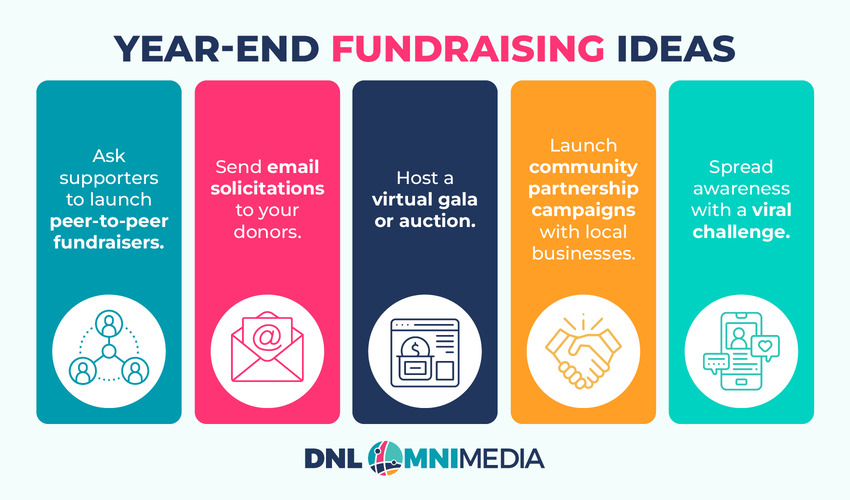
Peer-to-Peer Fundraising Campaign
This style of online fundraising is extremely well-suited to the virtual environment. Encourage supporters to launch fundraisers on your behalf, with a deadline set for the end of the year. Offer a fundraising guide and social media prompts with emotional appeals that participants can use to generate donations. Then, wrap it all up with an exciting virtual grand finale event.
Email Appeal
A classic email campaign is an effective way to secure donations during the year-end season. Donors regularly rank email as the communication outlet most likely to motivate them to give. Studies have shown that well-written, compelling, and lengthy email appeals generate more conversions than shorter messages. In fact, fundraising research has found that personalized emails see average open rates that are over 82% higher than that of generic emails.
Virtual Galas and Auctions
Even large-scale nonprofit events can be successfully adapted to the virtual or hybrid sphere, but they take plenty of planning and the right tech (especially livestreaming software and mobile bidding tools).
Here are some of the strategies today’s nonprofits use to host successful virtual and hybrid events:
- Incorporate interactive features like Q&A sessions, polls, live chats, and audience participation to keep attendees engaged.
- Provide virtual networking spaces for remote attendees to connect, network, and discuss topics of interest if relevant to your event.
- Choose a reliable and user-friendly virtual event platform that offers a seamless experience for attendees, including easy registration and livestream access.
- Ensure that speakers and attendees are familiar with the event platform. Conduct tech rehearsals to troubleshoot any issues.
If hosting a hybrid event, pay special attention to the needs of both virtual and in-person attendees so you can offer a seamless experience for everyone. You can also review case studies and examples of hybrid galas to learn the tactics and strategies that have proven effective for other nonprofits.
Community Partnership Campaigns
The year-end season is the ideal time to tap into your network of community partners and sponsors. Co-host virtual events with other nonprofits in your community, or reach out to local businesses and corporate sponsors to support your campaign and expand your audience.
We recommend focusing on corporate giving opportunities as a way to elevate results. For instance, you can focus on:
- Corporate donations. Whether businesses donate money or auction items for your gala, they can provide your nonprofit with much-needed support at year-end.
- Matching gifts. Through these programs, companies promise to match employees’ contributions to eligible nonprofits. As the end of the year is the last chance to make tax-exempt donations, it’s definitely a good idea to study up on and promote matching gifts.
- Volunteering. Line up volunteer opportunities with companies. This is a great way for businesses to promote teamwork among coworkers while supporting a worthwhile cause.
For the best results, make sure your fundraising software offers integrations with workplace giving tools. For example, some integrations enable auto-submission functionality, so donors can have your matching gift software automatically submit their matching gift requests to their employers.
At the very least, your corporate partners can encourage employees to research your cause and donate or volunteer if they feel inclined.
Viral Challenge Campaign
Remember the Ice Bucket Challenge that went viral on social media? That campaign raised over $115 million for the ALS Association. As a result, U.S.-based ALS treatment clinics nearly doubled, and funds helped scientists at Dartmouth launch a research program for the environmental causes of ALS, according to National Geographic.
With donors spending more time online than ever before, an engaging, meaningful, or just plain funny viral challenge can be the perfect way to raise visibility for your mission during the year-end season. For inspiration, you might launch one of the following:
- Plastic Free Challenge: Encourage participants to reduce their plastic usage and document their efforts. This type of challenge is great for raising awareness about plastic pollution’s impact on the environment.
- Do Good Challenge: Ask participants to perform random acts of kindness and share their experiences on social media, inspiring others to spread positivity and goodwill.
- No Tech Challenge: Challenge individuals to unplug from technology for a set time period and share their experiences after the fact. This campaign promotes mindfulness and mental health while highlighting the importance of balance.
Remember that the success of a viral challenge campaign depends on creativity and the ability to leverage social media to spread the message and encourage participation. Ask anyone who doesn’t complete the challenge to donate to your cause instead. Just be sure to provide easy-to-use donation tools for users who feel inspired to give.
Wrapping Up
By following just a few core steps and best practices, any nonprofit can consistently break their own fundraising records each year-end giving season! Especially amid today’s unprecedented challenges, making the most of this period should be a top priority for every fundraising organization.
The most important takeaway from this guide should be to get started early. As long as you put plenty of time and thought into your campaign strategies, you can effectively tap into the generous spirit of the year-end season, raising more support for your mission and building deeper relationships with donors in the process.
